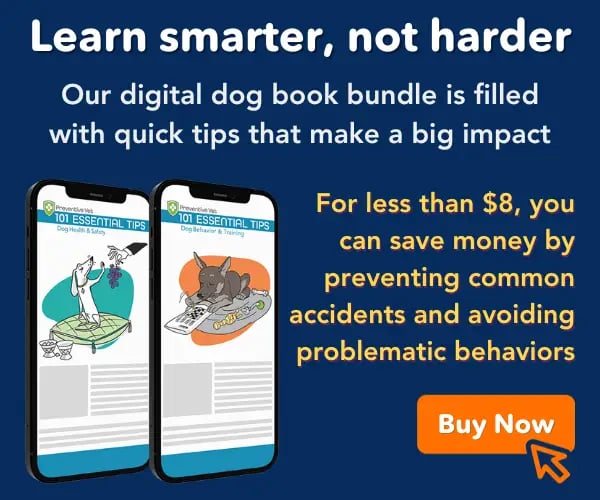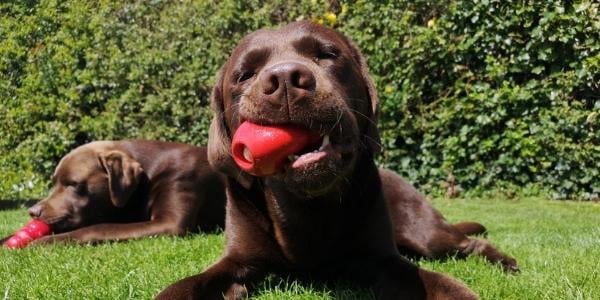 As a dog trainer, I firmly believe we should “ditch the bowl” when it comes to feeding our dogs.
As a dog trainer, I firmly believe we should “ditch the bowl” when it comes to feeding our dogs.
Dogs are natural foragers and using a food puzzle or interactive feeder means they get to put those foraging instincts to work.
Interactive dog feeders and dog puzzles are one of the easiest ways to enrich your dog’s life and burn excess energy.
Work-to-eat toys are perfect to give your dog on busy days to keep them occupied while you have a work call or get the kids ready for school. And they can even help a dog who is a picky eater get more excited about finishing their meal!
Table of Contents
There are lots of different types of dog food puzzles on the market. How do you choose which one your dog will enjoy most?
There are a few things to consider when it comes to picking out an interactive feeder for your dog to make sure you get the most bang for your buck.
And then how do you go about introducing your dog to eating from puzzles? I've got you covered, so read on.
I'll even share my tried-and-true favorite dog feeders that I use.
Click here for a shopping list of all of the feeder and toy options featured in this article (plus more of my favorites).
How to Choose the Best Interactive Dog Feeder
There are different types of interactive dog feeders, and every dog is unique and has different preferences. You may want to try a few to see which they like best, and then you can donate any that you don't want to keep to your local dog shelter or rescue.
It's always good to provide a variety of feeders and puzzles to your dog, so having more than one type to use is a good idea.
Stuffable Feeders
These feeders are for stuffing your dog’s food and treats, encouraging licking to empty them. Licking is a great decompression activity for hyper or anxious dogs. Stuffable feeders work best with dry food soaked in water, wet dog food, or a mixture of both. Here's a picture of one of our office dog's meal mixtures in their Toppl – it's perfect for slowing down their eating.
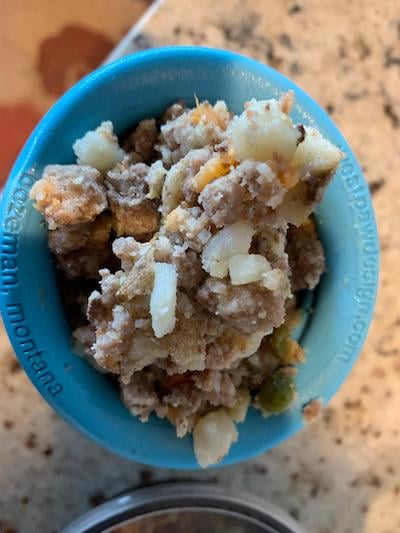
Shopping Tips:
- Easy to clean – Look for dishwasher-safe stuffable dog toys for maximum disinfecting potential.
- Choose the correct size for your dog. It should be too large for them to fit completely in their mouth or swallow.
You can use dry food only (especially when first starting), but that doesn't take full advantage of the stuffable toy. Popular stuffable dog toys include the KONG Classic and West Paw Toppl.
Here's my dog Fozzie as a puppy using a small Toppl for a midday snack:
Rollerballs & Tipper Feeders
Dogs knock and nudge these around with their nose or paws to get the dry food to come out. These feeders work only with dry food and small treats. One of the most popular tippers is the KONG Wobbler, which is nice and sturdy, and easy to clean.
Shopping Tips:
- Easy to clean – Choose a rollerball or tipper toy that comes apart easily and is dishwasher-safe.
- Make sure that the rollerball is too large for your dog to fit completely in their mouth, so it doesn't become a choking hazard.
- Do you have hardwood floors or tile? Some rollerballs and tippers are made from hard plastic that is loud or can damage the flooring if your dog gets extra "pawsy" with it.
Bonus Tip: You can take two West Paw Toppls (one small, one large) and fit them together to use as a roller instead of a stuffable, like so:
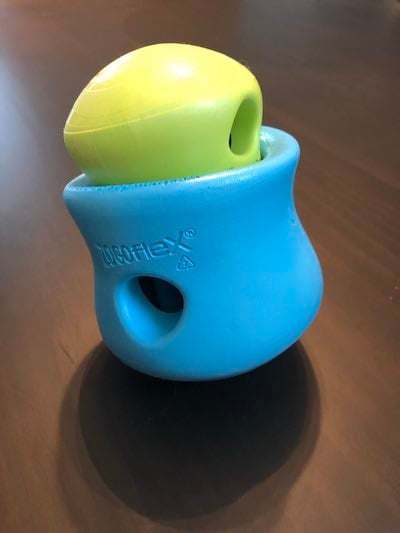
Snuffle Mats
Snuffle mats are made for putting your dog's nose to work! These mats are usually made of fleece or cotton. Spread dry food or a few treats into a snuffle mat and a dog will have to search out each bit with the power of their nose.
Shopping Tips:
- You'll want a snuffle mat that's easy to throw in the laundry but sturdy enough that it doesn't come apart after only a few washes.
Snuffle mats are excellent for slowing down fast eaters. Here's a video of my dog Sookie enjoying the DiffLife Snuffle Mat. I love how large it is and how it has pockets and flaps in addition to the traditional fabric strips.
Licking Mats
Licking mats are great for wet food smears. If your dog eats primarily wet food or you want to give them a quick snack (or distract them while you trim a nail or two), grab a licking mat!
Shopping Tips:
- Choose a licking mat that's easy to pop in the dishwasher for maximum disinfecting potential. Make sure to handwash any deep ridges or grooves machine washing.
I use the IQ Treat Mat from Hyper Pet, which you can see Fozzie Bear working on in this video:
Puzzle Feeders
These interactive feeders require your dog to solve parts of the puzzle to get their food, such as by moving a cup out of the way, spinning a tower, or pulling out a little drawer after “unlocking” it first.
Dog puzzles in a variety of difficulty levels and most are made for dry food or treats only. Nina Ottosson by Outward Hound and TRIXIE have a variety of well-made puzzles for dogs.
The food puzzle from Loobani shown in the video below is great for pups just getting started with food puzzles. It provides mental enrichment without being so hard that they'll get frustrated.
It took Finnegan about ten minutes to figure out how to paw at it to get the toy to spin and win the treat jackpot.
Shopping Tips:
- Pick a dog puzzle that's dishwasher-safe and be aware of certain materials that are handwash only (like some of the wood puzzles.
- Think about whether your dog will try to chew and swallow the smaller removable pieces of puzzles. If they are an "inhaler," choose a puzzle that doesn't come apart or smaller detachable pieces.
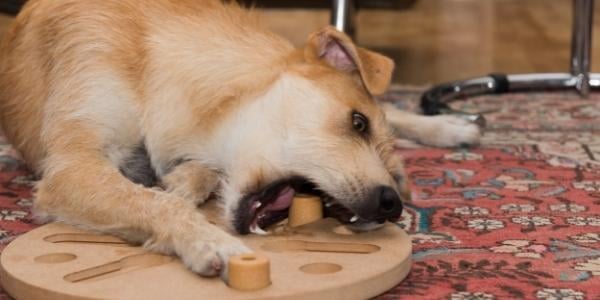
Slow-Feeder Dog Bowls
These bowls are designed to slow down your dog's eating but aren't as interactive as the options above. With lots of designs, the goal is to make it difficult for a dog to grab large mouthfuls of food at once. Instead, they have to lick the kibble from the bowl's small troughs one or two pieces at a time.
Shopping Tips:
- Choose a material that's easy to clean and dishwasher-safe.
In my experience, slow feed bowls help prevent a dog from gulping down too much food at once, but typically don't add more than a few minutes to mealtime. They can help for dogs who are pre-disposed to Bloat/GDV.
I also like the Trixie Slide & Feed game bowl because it combines a slow feeder with a small puzzle. Perfect for dogs where a slow feeder bowl just isn't quite enough of a challenge. I've used the Outward Hound Fun Feeder Slo Bowl for my dogs when they are puppies, as you can see in this video.
DIY Dog Food Puzzles
There are lots of ways to make your own versions of dog feeders and puzzles using things you already have at home. Craft your own snuffle mat or, if you have a yard, grass works just as well! Even a cardboard box and some packing paper can be turned into a fun feeding game. Here's my dog, Fozzie Bear, finishing up his dinner that I scattered in a box:
What’s Your Dog’s Skill Level?
Is your dog brand new to puzzle feeders? I’ve had many clients push back when I recommend using work-to-eat toys because they say, “my dog doesn’t like those.” What’s usually happened is that the puzzles they tried were too hard for their dog’s skill level. When a dog can't get the food out, they get frustrated and give up.
If you have a young puppy or a dog who hasn’t used an interactive feeder before, choose a food puzzle that has a large opening or dispenser that’s easy to activate. My favorite to start with is the West Paw Toppl because of the large opening and overall shape that makes it easy to lick out all of the food. Compare that to a KONG, which has a small opening and gets narrower, making it hard to get the last bit of food out. I own a total of eight Toppls, mostly the large size so I can stuff an entire meal in there, but some small sizes for snacks or for snapping into a large one to make a roller toy. With this many on hand, I can prep and freeze multiple meals to use throughout the week which saves me tons of time on busy days.
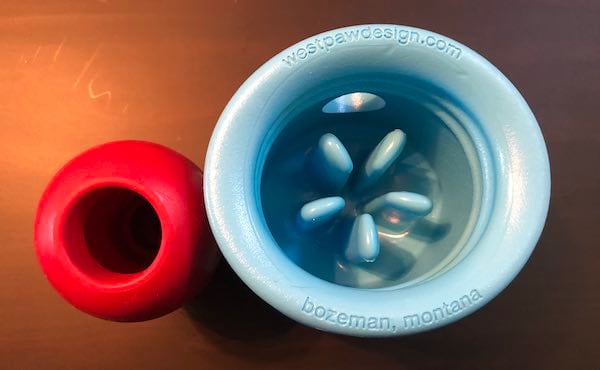 Once your dog has learned how to use interactive feeders and easy puzzles, then you can increase their difficulty level by freezing, using a different shape, or trying a harder puzzle level. Learn how to introduce your dog to food puzzles further below.
Once your dog has learned how to use interactive feeders and easy puzzles, then you can increase their difficulty level by freezing, using a different shape, or trying a harder puzzle level. Learn how to introduce your dog to food puzzles further below.
What Does Your Dog Like?
The texture and material of a dog interactive feeder are important to consider. To increase enrichment, I like to try out a variety for my dogs and mix up what I use for each meal. It may be a Toppl for breakfast and a snuffle mat for dinner. And then the next day I use a puzzle in the morning and a rollerball in the evening.
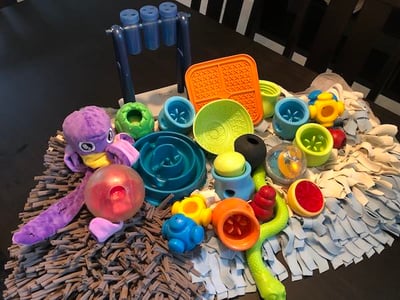
Variety is the spice of life. It only counts as enrichment if it's not the same thing day after day. Plus, mixing up your dog’s work-to-eat toys helps them stay interested and engaged with each feeder or puzzle.
What kinds of toys does your dog gravitate towards? If they avoid tough materials and aren’t intense chewers, then consider a stuffable matched to their chewing level. KONG has a puppy version and a senior version made from soft rubber that’s gentler on teeth and gums. The Toppl and KONG Classic hold up to moderate chewers, while KONG has the extreme rubber version for dogs who are more intense in their chewing.
Does your dog love to lick? Stuffables and licking mats are the way to go! These are meant to encourage licking, so if you notice your dog is trying to chew on the feeder rather than lick the food out, try a different type of puzzle toy. And if they only chew on it only after finishing their meal, be sure to put it away once they are done so they don’t destroy it.
Does your dog like to roll things around? My Corgis love to herd their roller balls around the house and gobble up the kibble that falls out. But for some dogs, this can be tiring. If you have a dog with mobility issues, consider a stuffable, mat, or stationary puzzle type, or reduce their area for rolling by using an ex-pen or smaller enclosed room.
I rotate between the Orbee-Tuff Mazee ball and the Pet Zone IQ Treat ball for my two dogs. Here's my dog, Sookie, with her Orbee-Tuff Mazee ball – it keeps her occupied for quite a while!
Rollers come in different materials as well, from hard plastic to soft rubber. If you have a hard plastic rollerball, the noise it makes on hardwood floors, tile, or when it hits the wall can startle a dog and make them avoid it. Plus, rollers can get stuck easily under cabinets or behind furniture. If you’re not around to help your dog retrieve them, they can get frustrated and start barking or simply give up.
Safety First!
When choosing an interactive dog feeder, make sure it is the correct size for your dog. It should be too large to swallow. You don't want your dog choking or swallowing their stuffable toy. There are quite a few stories of dogs swallowing KONGs whole. In the x-ray below, a mother dog ingested the small-sized KONGs that were meant for her puppies to enjoy.
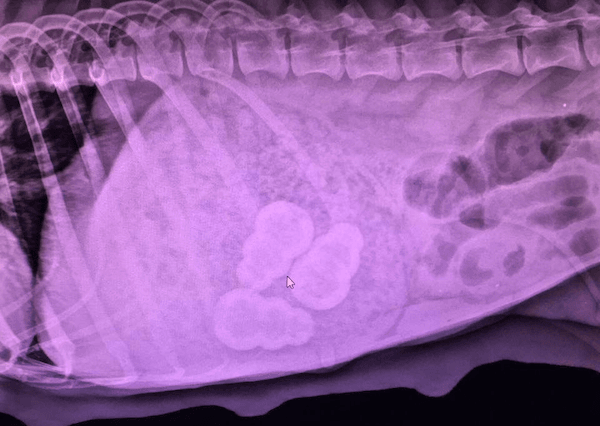
If you have multiple dogs of different sizes, give them their interactive feeders and puzzles separately and pick them up immediately after your dog finishes with them. This helps prevent the larger dog from ingesting and smaller toy and helps prevent resource guarding.
Supervise your dog when they are working on puzzles to make sure they aren't breaking off or swallowing pieces. Remove interactive feeders once your dog is finished with their food, as you don't want your dog ripping up licking mats or destroying their snuffle mat.
If using a DIY feeding activity, know your dog's tendencies when it comes to whether they ingest cardboard or paper. Some dogs simply like to rip it up and then ignore it, but others find it a nice snack. If your dog is likely to swallow non-food materials, avoid those in your DIY puzzles.
Choosing Puzzles and Interactive Toys for Your Dog's Breed
While many dogs enjoy many types of puzzles and toys, picking specific toys that satisfy their particular breed drives goes a long way in burning energy and reducing problem behaviors. Your dog's historical jobs were direct results of both natural and artificial selection that changed your dog's body type and natural drives. Particular puzzles and toys may better meet their body type (such as long noses vs. short noses) and mimic the job they are meant to do/
Take this quiz to get personalized enrichment and puzzle ideas for your dog's breed or breed mix:
How to Teach Your Dog to Use a Food Puzzle
Puppies and dogs new to “working” for their food need to have easy success when they first start. If it’s too difficult to get the food out of the puzzle toy, frustration builds, and many dogs just give up, leaving a mostly full puzzle toy in the corner that we then have to de-stuff and clean (which can be quite a chore). We want a puzzle feeder to keep the dog’s interest. To do this, we need a puzzle that rewards your dog at a reliable pace.
Help your dog when they need it. If they seem to be struggling to get food out of their interactive feeder, you can help them out by knocking sticky pieces loose from the bottom or shaking the toy so that kibble is closer to the opening for them. Point out missed pieces of food in snuffle mats.
If your dog is learning how to use a puzzle, make sure it is set to the easiest level and then show them how to open the compartment or move the piece. You can even leave the puzzle parts half-open so they can get the hang of manipulating them.
Introducing Your Dog to a KONG, Toppl, or Other Stuffable Feeder
- Smear a small bit of peanut butter (make sure it's xylitol-free) or wet food on the outside and inside of the opening. This helps a dog learn where to lick.
- Fill the stuffable with just a spoonful of totally dry food and add the smear of wet food or peanut butter on the lip. Don't overstuff with dry food, as that can make the kibble hard to empty out. With less food inside, it's easy for bits to fall out and your dog to get rewarded for interacting with the toy. If you use only wet food with your dog, smear the wet food inside the stuffable but keep it close to the opening so it doesn't get stuck at the bottom and out of your dog's reach.
- Once your dog has the hang of knocking out the dry food and licking off the smear, start to soak the food in water (or low-sodium and unseasoned broth) before stuffing the toy. If using wet food, start to fill the toy more than you have been in previous steps.
- As your dog gets confident in eating from the stuffable toy and isn't leaving any uneaten, then you can make it a bit harder.
Bonus Tip: To make a stuffable more enticing, put higher-value food or treats at the bottom of the toy, layering their regular food on top of it. This way your dog has to work through dinner to get their "dessert"!
How to Make Interactive Feeders and Dog Puzzles More Challenging
Once your dog has the hang of eating from their puzzle or feeder, you can keep things interesting by increasing the difficulty levels.
- Place a puzzle or roller on top of a snuffle mat to extend the fun. Check out Fozzie working on his Trixie Turn Around Puzzle over his snuffle mat in this video:
- Start hiding multiple interactive feeders (each filled with just a portion of the meal) around the room for some nose work practice.
- Some roller feeders have adjustable levels or interchangeable parts to make it harder to get the kibble out.
- Think about layering different brain games around the interactive feeder to make it more challenging. Put a stuffable inside of a cardboard box so your pup has to first figure out how to get it out.
Freezing a stuffable or lick mat is the easiest way to make mealtime last longer. My dog takes about 5 minutes to finish an unfrozen Toppl but when it's fully frozen, it lasts 45 minutes! Chilled or frozen stuffable toys are great for hot summer days or for puppies who are teething. I recommend against freezing it solid the first few tries to prevent your dog from getting frustrated. Par-freeze or thaw for a bit before giving it to your dog so it's not too taxing for your dog to finish.
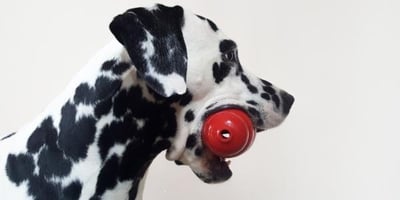 Why You Should Use Interactive Dog Feeders and Puzzles
Why You Should Use Interactive Dog Feeders and Puzzles
- Provides Enrichment: All dogs can benefit from more enrichment in their daily lives, and swapping regular food bowls out for food puzzles is the simplest way to start. They provide sensory enrichment for a dog's sense of taste, smell, and texture, and behavioral enrichment by working their brain. Click to get more ideas for increasing your dog's enrichment beyond puzzles at mealtime.
- Slows Down Dogs Who Eat Too Fast: If your dog eats too quickly, they are at higher risk of choking or bloat – which can be deadly. Some breeds are predisposed to higher bloat risk, and the condition can be fatal. Slow feeder bowls, puzzles, and interactive feeders mean your dog can only take one bite (or lick) at a time.

- Helps Dogs Who Are Picky Eaters: Some dogs just need to have that work-to-eat aspect of their meals to get them interested. I've found that many picky dogs I've worked with enjoy interactive toys and puzzles for their meals. You can mix in some high-value treats to entice them to eat the regular food as they get closer to the extra yummy stuff.
- Soothes Puppy Teething: Teething is not a fun process and puppies need to chew to relieve the discomfort they feel in their mouths. Giving them a chilled stuffable can soothe their gums and distract them from nipping and biting at you.
- Helps with Crate Training: We want a dog to love being in their crate! One of the easiest ways to do this is by pairing crate time with food time. Puzzle feeders take longer to finish, which means more continuous reinforcement for hanging out in the crate. And often a dog will be ready for a nice nap in the crate once they finish.
- Perfect Crate Rest Activity: If your dog is on crate rest after a surgery or injury, providing work-to-eat toys and puzzles gives them a way to burn excess energy, keeps them occupied, and prevents boredom. Pair meal enrichment and puzzles with simple, low-energy training cues, like teaching them a chin rest or touch cue while they recover.
- Calms Hyper or Anxious Dogs: Licking, chewing, and sniffing are very calming activities for dogs. The repetitive nature of working on a work-to-eat toy lowers heart rate and burns excess energy. Find more tips on how to calm down a hyper or anxious dog here.
Ditch your dog's regular bowl and make mealtime more fun and engaging. Your dog will thank you! Need more ideas? Check out this list for all the feeders mentioned above and more of my top picks for interactive feeders, dog puzzles, and slow-feeder bowls.


